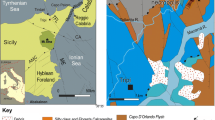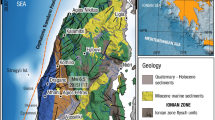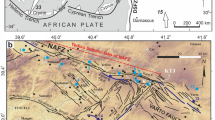Abstract
A moderate, shallow depth, earthquake (Mw = 6.5) occurred onshore Lefkada island on November 17, 2015 with the focal depth estimated at 11 km. The seismic fault is a near-vertical strike-slip fault running along the western coast, part of the Cephalonia Transform Fault. Landslides and ground cracks were mainly reported at the western part of the island, inducing structural damages. High severity slope failures occurred at Egremnoi and Gialos areas that both are located at coastal regions. This study aims to investigate the engineering geological conditions at these areas, and assess the characteristics and physical quantities (e.g., type, area—m2, and volume—m3) of the instabilities. To achieve this, engineering geological mapping was implemented in Egremnoi and Gialos area aiming to; (a) classify the geological units mapped on the heavily damaged areas and (b) to correlate them with the type of slope failures. Furthermore, type and dimensions of slope failures were evaluated to estimate the total volume of the mass movement. All the data, originated from the engineering geological mapping, have been digitized and rasterized at 5 m grid spacing using the Arc/Info GIS software to perform a Newmark’s sliding block analysis. The outcome arisen by this analysis is that the generated by the earthquake peak ground acceleration at these areas should be at least 0.45 g to trigger these kinds of slope failures.














Similar content being viewed by others
References
Amirahmadi A, Pourhashemi S, Karami M, Akbari E (2016) Modeling of landslide volume estimation. Open Geosci 8:360–370
Barton NR, Lien R, Lunde J (1974) Engineering classification of rock masses for the design of tunnel support. Rock Mech 6(4):189–239
Bell FG (2007) Engineering geology. Second Edition. ISBN-13: 978-0-7506-8077-6$4 ISBN-10: 0-7506-8077-6
Bieniawski ZT (1989) Engineering rock mass classifications. Wiley, New York
Bornovas I (1964) Geology of Lefkada Island. PhD Thesis
Chen W, Li X, Wang Y, Liu S (2013) Landslide susceptibility mapping using LiDAR and DMC data: a case study in the Three Gorges area, China. Environ Earth Sci 70:673–685. https://doi.org/10.1007/s12665-012-2151-8
Chen X-L, Liu C-G, Yu L, Lin C-X (2014) Critical acceleration as a criterion in seismic landslide susceptibility assessment. Geomorphology 217:15–22
Chung J, Rogers J, Watkins C (2014) Estimating severity of seismically induced landslides and lateral spreads using threshold water levels. Geomorphology 204:31–41
Cushing E (1985) Evolution stucturale de la marge nord-ouest hellenique dans l’ile de Levkas et ses environs (Greece nord-occidentale). PhD Thesis
Eeckhaut M, Kerle N, Herva´s J, Supper R (2013) Cover using object-oriented analysis and LiDAR derivatives. Landslide Sci Pract. https://doi.org/10.1007/978-3-642-31325-7_413
Ganas A, Elias P, Bozionelos G, Papathanassiou G, Avallone A, Papastergios A, Valkaniotis S, Parcharidis I, Briole P (2016) Coseismic deformation, field observations and seismic fault of the 17 November 2015 M = 6.5, Lefkada Island, Greece earthquake. Tectonophysics 687:210–222
Hack R, Huisman M (2002) Estimating the intact rock strength of a rock mass by simple means. Eng Geol Dev Countries. In: Proceedings of 9th congress of the International Association for Engineering Geology and the Environment. Durban, South Africa, 16–20 Sept 2002, pp 1971–1977
Harp E, Jibson R (1995) Seismic instrumentation of landslides: building a better model of dynamic landslide behavior. Bull Seismol Soc Am 85(1):93–99
Harp E, Jibson R (2002) Anomalous concentrations of seismically triggered rock falls in Pacoima canyon: are they caused by highly susceptible slopes or local amplification of seismic shaking? Bull Seismol Soc Am 92:3180–3189. https://doi.org/10.1785/0120010171
Harp E, Keefer DK, Sato HP, Yagi H (2011) Landslide inventories: the essential part of seismic hazard analyses. Eng Geol 122(1–2):9–21
Harp E, Jibson R, Dart R (2013) The effect of complex fault rupture on the distribution of landslides triggered by the 12 January 2010, Haiti Earthquake. Landslide Sci Pract 625(5):157–161
Harp E, Hartzell S, Jibson R, Ramirez-Guzman L, Schmitt R (2014) Relation of landslides triggered by the kiholo bay earthquake to modeled ground motion. Bull Seismol Soc Am 104(5):2529–2540. https://doi.org/10.1785/0120140047
Hasegawa S, Nonomura A, Uchida J, Kawato K, Kageura R, Chiba T, Onoda S (2015) Hazard mapping of earthquake-induced deep-seated catastrophic landslides along the median tectonic line in shikoku by using LiDAR DEM and airborne resistivity data. Eng Geol Soc Territ. https://doi.org/10.1007/978-3-319-09057-3_120
Havenith HB, Torgoev A, Braun A, Schlögel R, Micu M (2016) A new classification of earthquake-induced landslide event sizes based on seismotectonic, topographic, climatic and geologic factors. Geoenviron Disasters. https://doi.org/10.1186/s40677-016-0041-1
Hoek E (2006) Practical rock engineering. https://www.rocscience.com/learning/hoek-s-corner
Hovius N, Stark CP, Allen PA (1997) Sediment flux from a mountain belt derived by landslide mapping. Geology 25:231–234
ISRM (1981) Rock characterization, testing and monitoring. In: Brown ET (ed) ISRM suggested methods. Pergamon Press, Oxford, p 211
ITSAK (2015) Preliminary results of the earthquake Μ6.4 of 17/11/2015. http://www.itsak.gr
Jaafari A (2018) LiDARsupported prediction of slope failures using an integrated ensemble weightsofevidence and analytical hierarchy process. Environ Earth Sci 77:42. https://doi.org/10.1007/s12665-017-7207-3
Jibson R (2007) Regression models for estimating coseismic landslide displacement. Eng Geol 91:209–218
Jibson R, Harp E, Michael J (1998) A method for producing digital probabilistic seismic landslide hazard maps: an example from the Los Angeles, California Area. US Geological Survey Open-File Report, pp 98–113 (17 pp)
Jibson R, Harp E, Michael J (2000) A method for producing digital probabilistic seismic landslide hazard maps. Eng Geol 58:271–289
Keefer D (1984) Landslides caused by earthquakes. Geol Soc Am Bull 95:406–421
Keefer D (2002) Investigating landslides caused by earthquakes—a historical review. Surv Geophys 23:473. https://doi.org/10.1023/A:1021274710840
Lekkas E, Mavroulis S, Alexoudi V (2016) Field observations of the 2015 (November 17, Mw 6.4) Lefkas (Ionian Seas, Western Greece) earthquake impact on natural environment and building stock of Lefkas island. Bull Geol Soc Greece 50(1):499–510
Liu J, Shi J, Wang T, Wu S (2017) Seismic landslide hazard assessment in the Tianshui area, China, based on scenario earthquakes. Bull Eng Geol Env. https://doi.org/10.1007/s10064-016-0998-8
Malamud B, Turcotte D, Guzzetti F, Reichenbach P (2004) Landslide inventories and their statistical properties. Earth Surf Proc Land 29:687–711
Marinos V (2010) New proposed GSI classification charts for weak or complex rock masses. Bull Geol Soc Greece 4(3):1248–1258
Marinos P, Hoek E (2000) Predicting tunnel squeezing problems in weak heterogeneous rock masses. Tunnel Tunnell Int
Miles SB, Keefer DK (2000) Evaluation of seismic slope-performance models using a regional case study. Environ Eng Geosci 6(1):25–39
Miyagi T, Yamashina Sh, Esaka F, Abe S (2011) Massive landslide triggered by 2008 Iwate–Miyagi inland earthquake in the Aratozawa Dam area. Tohoku Jpn Landslides 8:99–108
Mountrakis D (2010) Geology and geotectonic evolution of Greece. Univeristy studio Press, pp 207 (ISBN 978-960-12-1970-7)
Newmark NM (1965) Effects of earthquakes on dams and embankments. Geotechnique 15:139–160
Ohmori H, Hirano M (1988) Magnitude, frequency and geomorphological significance of rocky mud flows, landcreep and the collapse of steep slopes. Zeitschrift fur Geomorphology (Suppl Bd) 67:55–65
Papadopoulos GA, Plessa A (2000) Magnitude-distance relations for earthquake–induced landslides in Greece. Eng Geol 58:377–386
Papathanassiou G (2012) Estimating slope failure potential in an earthquake prone area: a case study at Skolis Mountain, NW Peloponnesus, Greece. Bull Eng Geol Env 71:187–194. https://doi.org/10.1007/s10064-010-0344-5
Papathanassiou G, Pavlides S, Ganas A (2005) The 2003 Lefkada earthquake: field observations and preliminary microzonation map based on liquefaction potential index for the town of Lefkada. Eng Geol 82:12–31
Papathanassiou G, Valkaniotis S, Dimaras K (2015) Validating the classification of earthquake-induced landslide hazard levels based on data provided by large scale mapping of failures induced by 2003 Lefkada, Greece Earthquake. Eng Geol Soc Territory 2:737–741
Papathanassiou G, Valkaniotis S, Ganas A, Grendas N, Kollia El (2017) The November 17th, 2015 Lefkada (Greece) strike-slip earthquake: Field mapping of generated failures and assessment of macroseismic intensity ESI-07. Eng Geol 220:13–30. https://doi.org/10.1016/j.enggeo.2017.01.019
Papazachos BC, Comninakis PE, Karakaisis GF, Karakostas BG, Papaioannou ChA, Papazachos CB, Scordilis EM (2000) A catalogue of earthquakes in Greece and surrounding area for the period 550BC–1999. Publ Geoph Lab Univ of Thessaloniki. pp 333
Pelletier JD, Malamud BD, Blodgett T, Turcotte DL (1997) Scale-invariance of soil moisture variability and its implications for the frequency-size distribution of landslides. Eng Geol 48:255–268
Rodrıguez-Peces MJ, Garcıa-Mayordomo J, Azanon JM, Jabaloy A (2014) GIS application for regional assessment of seismically induced slope failures in the Sierra Nevada Range, South Spain, along the Padul Fault. Environ Earth Sci 72:2423–2435. https://doi.org/10.1007/s12665-014-3151-7
Rondoyanni Th, Sakellariou M, Baskoutas J, Christodoulou N (2012) Evaluation of active faulting and earthquake secondary effects in Lefkada Island, Ionian Sea, Greece: an overview. Nat Hazards 61:843. https://doi.org/10.1007/s11069-011-0080-6
Salinas-Jasso J, Ramos-Zuñiga L, Montalvo-Arrieta J (2017) Regional landslide hazard assessment from seismically induced displacements in Monterrey Metropolitan area, Northeastern Mexico. Bull Eng Geol Env. https://doi.org/10.1007/s10064-017-1087-3
Saroglou H, Asteriou P, Tsiambaos G, Zekkos D, Clark M, Manousakis J (2017) Investigation of co-seismic Rockfalls During the 2015 Lefkada and 2014 Cephalonia Earthquakes in Greece. 3rd North American Symposium on Landslides, Roanoke, VA, June 4–8, 2017
Sasaki Y, Abe M, Hirano I (1991) Fractals of slope failure size-number distribution. J Jpn Soc Eng Geol 32:1–11
Shugen L, Bin D, Zhiwu L, Luba J, Shun L, Guozhi W, Wei S (2013) Geological evolution of the longmenshan intracontinental composite orogen and the eastern margin of the Tibetan Plateau. J Earth Sci 24(6):874–890. https://doi.org/10.1007/s12583-013-0391-5
Simonett DS (1967) Landslide distribution and earthquakes in the Bewani and Torricelli Mountains, New Guinea. In: Jennings JN, Mabbutt JA (eds) Landform studies from Australia and New Guinea. Cambridge University Press, Cambridge, pp 64–84
Tang CL, Hu JC, Lin ML, Yuan RM, Cheng CC (2013) The mechanism of the 1941 Tsaoling landslide, Taiwan: insight from a 2D discrete element simulation. Environ Earth Sci 70:1005–1019. https://doi.org/10.1007/s12665-012-2190-1
Valkaniotis S, Ganas A, Papathanassiou G, Papanikolaou M (2014) Field observations of geological effects triggered by the January–February 2014 Cephalonia (Ionian Sea, Greece) earthquakes. Tectonophysics 630:150–157. https://doi.org/10.1016/j.tecto.2014.05.012
Varnes DJ (1978) Slope movement types and processes. In: Schuster RL, Krizek RJ (eds) Landslides, analysis and control, special report 176: transportation research board. National Academy of Sciences, Washington, DC, pp 11–33
Ventura G, Vilardo G, Terranova C, Sessa E (2013) 4D monitoring of active landslides by multi-temporal airborne LiDAR data. Landslide Sci Pract. https://doi.org/10.1007/978-3-642-31445-2_419
Vessia G, Pisano L, Tromba G, Parise M (2017) Seismically induced slope instability maps validated at an urban scale by site numerical simulations. Bull Eng Geol Env 76:457–476. https://doi.org/10.1007/s10064-016-0940-0
Wang K-L, Lin M-L (2010) Development of shallow seismic landslide potential map based on Newmark’s displacement: the case study of Chi-Chi earthquake, Taiwan. Environ Earth Sci 60:775–785. https://doi.org/10.1007/s12665-009-0215-1
Wang Y, Song C, Lin Q, Li J (2016) Occurrence probability assessment of earthquake-triggered landslides with Newmark displacement values and logistic regression: the Wenchuan earthquake, China. Geomorphology 258:108–119
Xu C, Xu X, Yao X, Dai F (2014) Three (nearly) complete inventories of landslides triggered by the May 12, 2008 Wenchuan Mw 7.9 earthquake of China and their spatial distribution statistical analysis. Landslides 11:441–461
Xu C, Xu X, Shen L, Yao Q, Tan X, Kang W, Ma S, Wu X, Cai J, Gao M, Li K (2016) Optimized volume models of earthquake-triggered landslides. Sci Rep 6:29797. https://doi.org/10.1038/srep29797
Zekkos D, Clark M, Cowell K, Medwedeff W, Manousakis J, Tsiambaos G, Saroglou H (2017) Satellite and UAV-enabled mapping of landslides caused by the November 17th 2015 Mw 6.5 Lefkada earthquake. Proceedings of the 19th International Conference on Soil Mechanics and Geotechnical Engineering, Seoul 2017
Acknowledgements
This research was supported by the Aristotle University of Thessaloniki (A.U.TH.) as a master thesis during the period 06/2016–12/2016. Local community is also acknowledged for providing us with helpful information regarding the areas of interest.
Author information
Authors and Affiliations
Corresponding author
Rights and permissions
About this article
Cite this article
Grendas, N., Marinos, V., Papathanassiou, G. et al. Engineering geological mapping of earthquake-induced landslides in South Lefkada Island, Greece: evaluation of the type and characteristics of the slope failures. Environ Earth Sci 77, 425 (2018). https://doi.org/10.1007/s12665-018-7598-9
Received:
Accepted:
Published:
DOI: https://doi.org/10.1007/s12665-018-7598-9




